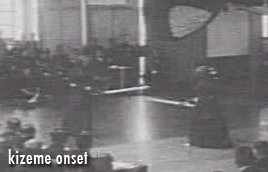Kizeme
Kizeme (気攻め) is a Japanese term describing the advanced form of seme when a kendo player has succeeded in causing shift in the mind (attention) of the opponent.[1] Kendoka at that stage takes the offensive mainly through Ki, succeeding in disconcerting the opponent via KI-projection and at much higher skill level without visible gesture.[2]
Kizeme is act of combat predominant in Kendo and should be regarded in contrast to ordinary levels of combat in which the awareness of the practitioners is limited to the most directly perceptible elements: speed, strength and sheer aggressiveness. The last can be used to delineate 3 levels of combat (see the 3 sketches on your right).[3] These 3 levels were elegantly described in a compelling allegory by Issai Chosan (1727) Neko no Myojutsu ("The Cat's Eerie Skill").[4] Kizeme is depicted as the perfect skill in martial art, where non-violence is still an artifice that can be detected and exploited to dismiss the naturally embedded aggression in the ego and reach harmony – the state of Muga-mushin.
An instructive attestation of kizeme can be seen in a demonstration kendo match at Noma dojo by Moriji Mochida (ju-dan hanshi) during the Emperor's Cup (1940).

- "Swordsmanship is basically the exercising of the Life Force and, therefore, at the beginning of the study the Life Force is exercised by means of technique."[5]
See also
- Budō
- Bushido
- Feint – similar concept in Western swordsmanship
- Fudoshin
- Kendo
- Ma-ai
- Mushin (mental state)
- Qi
- Zen Buddhism
References
- ↑ Ki and the Way of the Martial Arts by Kenji Tokitsu, Shambhala, 2003, pp. 31–36
- ↑ The Technical and Psychological Methodology of Kendo by Oya Minoru, Kendo World 1(4) 2002 pp. 5–9, 2(1) 2003, pp. 24–7
- ↑ Miyamoto Musashi: His Life and Writings, by Kenji Tokitsu, Shambhala, 2004, p. 330
- ↑ The Overlook Martial Arts Reader V2 ed. by John Donohue, The Overlook Press, 2004, pp. 106–113
- ↑ Issai Chozan, Tengu-geijutsu-ron (Discourse on the Art of the Mountain Demons, 1729) trans. in Zen and Confucius in the Art of Swordsmanship by Reinhard Kammer. Routledge & Kegan Paul, 1978